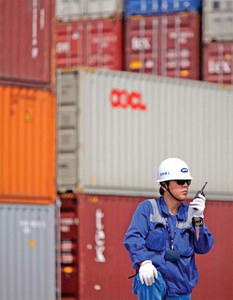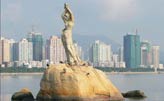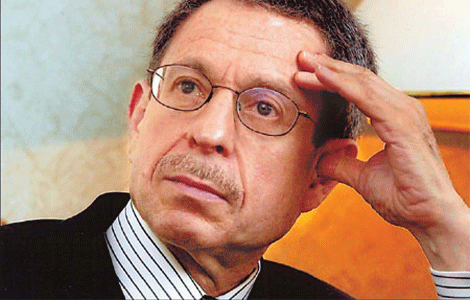Undeveloped markets in line for rough ride
Updated: 2011-09-07 09:25
By Bao Chang (China Daily)
|
|||||||||
A dock employee monitors containers at the Yangshan Deep Water Port in Shanghai. The United Nations Conference on Trade and Development said the world economy is slowing. [Photo / Bloomberg]

A report from UNCTAD suggests slowdown in developed economies
URUMQI - Having re-established pre-crisis growth trends, the world's developing economies could now be affected by recession in the developed countries where economic revitalization is slowing, said Supachai Panitchpakdi, secretary-general of the United Nations Conference on Trade and Development (UNCTAD).
He made the remark during the first China-Eurasia Expo held in Urumqi, the capital of the Xinjiang Uygur autonomous region, where UNCTAD released its 2011 Trade and Development Report. The report will be officially published globally on Sept 7.
It shows that after a rapid post-crisis recovery, the world economy is slowing, from about 4 percent GDP growth in 2010 to 3 percent in 2011.
Growth is strong in developing economies, which have resumed their pre-crisis growth trends and are expanding at more than 6 percent this year. In contrast, the world's developed economies will only grow by between 1.5 and 2 percent in 2011, according to UNCTAD.
East Asia, Southern Asia and Southeast Asia have recorded the highest GDP growth rates of more than 7 percent in 2011.
"Although growth in developing countries has become more and more dependent on the expansion of domestic markets, they still face significant external risks, remaining vulnerable to trade and financial shocks, because of economic weakness in the developed economies and a lack of reform in international financial markets," said Panitchpakdi.
In 2011, the international trade volume growth is expected to return to single-digit from 14 percent in 2010, particularly in the developed economies, according to the report.
"The growth of international trade will be between 7 and 8 percent in 2011, half of that of last year, as we have seen more and more trade restrictions, currency wars and fiscal tightening in the global market," Panitchpakdi said.
In the United States, the recovery has been stalling as domestic demand has remained subdued due to stagnating wages and employment. With interest rates at historically low levels for the foreseeable future and the fiscal stimulus waning, a quick return to a satisfactory growth trajectory is highly unlikely, the report said.
In the European Union, income growth remained low in the second quarter of 2011. Meanwhile, the prospect of fiscal austerity measures spreading across Europe may mean that there is a high risk that the eurozone will continue to act as a significant drag on global growth. In fact, recent plunges in stock markets largely reflect the worsening growth perspective.
Asia is also undergoing a moderate slowdown owing to supply-chain effects after the March earthquake in Japan, plus tighter monetary conditions and weak demand in some major export markets, the report said.
"In contrast with the main surplus developed economies, Germany and Japan, where net exports continue to be the major engine for growth, some large surplus developing and emerging economies such as China and Russia are honoring their commitment to help reduce global imbalances," Panitchpakdi added.
He added that at present China's GDP growth is no longer solely reliant on export increases, but rather on the rapid pace of investment in infrastructure and domestic consumption.











